The piston I s now pulled out slowly and held at a diatance 2L from the top. The pressure in the cylinder between its top and the piston will then be
P0
P0/2
P02+MgϕR2
P02−Mgϕr2
The correct Answer is:D
Topper's Solved these Questions
- KINETIC THEORY OF GASESBOOK - BANSALCHAPTER - KINETIC THEORY OF GASESEXERCISE - Section-B
13 Videos
- KINETIC THEORY OF GASESBOOK - BANSALCHAPTER - KINETIC THEORY OF GASESEXERCISE - Exercise-3
33 Videos
- HEAT TRANSFERBOOK - BANSALCHAPTER - HEAT TRANSFEREXERCISE - Exercise
89 Videos
- UNIT DIMENSION, VECTOR & BASIC MATHSBOOK - BANSALCHAPTER - UNIT DIMENSION, VECTOR & BASIC MATHSEXERCISE - Exercise
10 Videos
Similar Questions
A fixed thermally conducting cylinder has a radius R and height L0. The cylinder is open at the bottom and has a small hole at its top. A piston of mass M is held at a distance L from the top surface, as shown in the figure. The atmospheric pressure is P0.
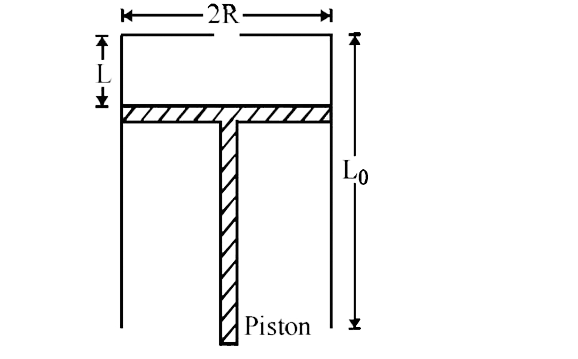
The piston is now pulled out slowly and held at a distance 2L from the top. The pressure in the cylinder between its top and the piston will then be
View SolutionA fixed thermally conducting cylinder has a radius R and height L0. The cylinder is open at its bottom and has a small hole at its top. A piston of mass M is held at a distance L from the top surface, as shown in the figure. The atmospheric pressure is P0.
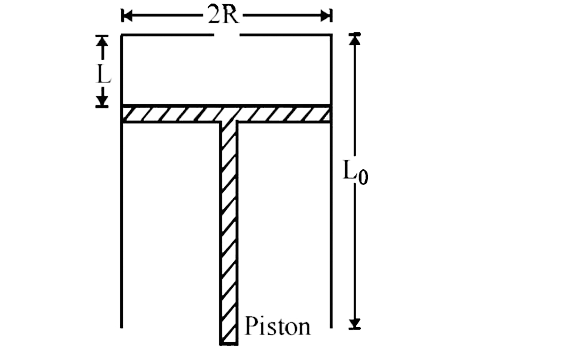
While the piston is at a distance 2L from the top, the hole at the top is sealed. The piston is then released, to a position where it can stay in equilibrium. In this condition, the distance of the piston from the top is
View Solution
Knowledge Check
A fixed thermally conducting cylinder has a radius R and height L0. The cylinder is open at ita bottom and has a small hole at its top. A piston of mass M is held at a distance L from the top surface, as shown in the figure. The atmospheric pressure is P0.

The piston is now pulled out slowly and held at a distance 2L from the top. The pressure in the cylinder between its top and the piston will then beAP0BP02CP02+MgπR2DP02−MgπR2A fixed thermally conducting cylinder has radius R and length L0. The cylinder is open at its bottom and has a small hole at its top. A piston of mass M is held at a distance L from the top surface, as shown in the figure. The atmospheric pressure is P0.
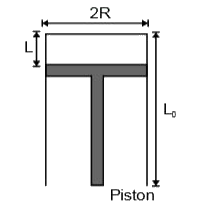
While the piston is at a distance 2L from the top, the hole at the top is sealed. The piston is then released, to a position where it can stay in equilibrium. In this condition, the distance of the piston from the top isA(2P0πR2πR2P0+Mg)(2LB(p0πR2−MgπR2P0)(2L)C(p0πR2+MgπR2P0)(2L)D(P0πr2πR2P0−Mg)(2L)A fixed thermally conducting cylinder has a radius R and height L0. The cylinder is open at ita bottom and has a small hole at its top. A piston of mass M is held at a distance L from the top surface, as shown in the figure. The atmospheric pressure is P0.

While the piston is at a distance 2L from the top, the hole at the top is sealed. The piston is then released, to a position where it can stay in equilibrium. In this condition, the distance of the piston from the top isA(2P0πR2πR2P0+Mg)(2L)B(P0πR2−MgπR2P0)(2L)C(P0πR2+MgπR2P0)(2L)D(P0πR2πR2P0−Mg)(2L)
(i) An adiabatic cylinder contains an ideal gas. It is fitted with a freely movable insulating piston. In one experiment the piston is pulled out very fast to double the volume of the gas. In another experiment starting from same initial state, the piston is pulled out very slowly to double the volume of the gas. At the end of which experiment the final pressure of the gas will be higher?
(ii) An ideal gas is contained in a cylinder fitted with a movable piston. In an experiment ‘A’ the gas is allowed to perform a work W(>0) on the surrounding during an isobaric process and thereafter the pressure of the gas is reduced isochorically to half the initial value. At the end of the experiment the temperature of the gas is TA. In a different experiment ‘B’ the pressure of the gas is reduced to half in an isochoric process and then the gas performs a work W on the surrounding during an isobaric process. At the end of the experiment the gas temperature is TB. Which is higher, TA or TB?
View SolutionIn a cylindrical container two pistons enclose gas in two compartments as shown in the figure. The pistons have negligible thickness and can move without friction. The sys- tem is originally in equilibrium. The outer piston is slowly moved out by 10 cm and the inner piston is found to move by 4 cm. Find the distance of the inner piston in equilibrium from the closed end of the cylinder if the outer piston is slowly moved out of the cylinder. Assume temperature of the gas to remain constant.
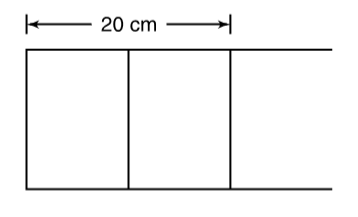
View SolutionA vertical closed cylinder is separated into two parts by a frictionless piston of mass m and of negligible thickness. The piston is free to move along the length of the cylinder. The length of the cylinder above the piston is l1, and that below the piston is l2, such that l1>l2. Each part of the cylinder contains n moles of an ideal gas at equal temeprature T. If the pistion is stationary, its mass, m, will be given by : (R is universal gas constant and g is the acceleration due to gravitey)
View SolutionWhile the piston is at a distance 2L from the top, the hole at the top is sealed. The piston is then released, to a poistion where it can stay in equilibrium. In this condition, distance of the piston from the top is
View SolutionA fixed thermally conducting cylinder has a radius R and height L0. The cylinder is open at ita bottom and has a small hole at its top. A piston of mass M is held at a distance L from the top surface, as shown in the figure. The atmospheric pressure is P0.
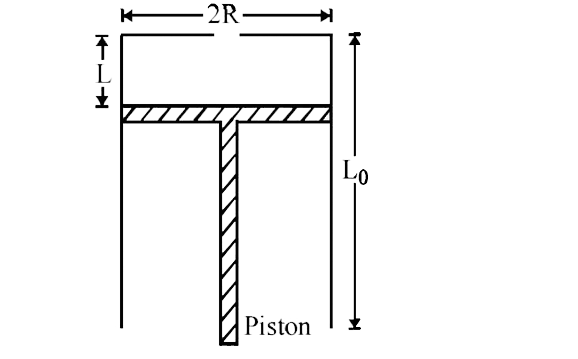
The piston is taken completely out of the cylinder. The hole at the top is sealed. A water tank is brought below the cylinder and put in a position so that the water surface in the tank is at the same level as the top of the cylinder as shown in the figure. The density of the water is ρ. In equilibrium, the height H of the water coulmn in the cylinder satisfies
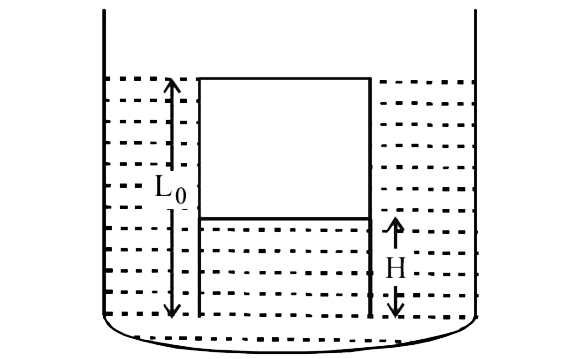
View Solution
